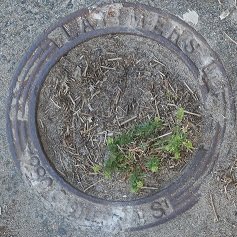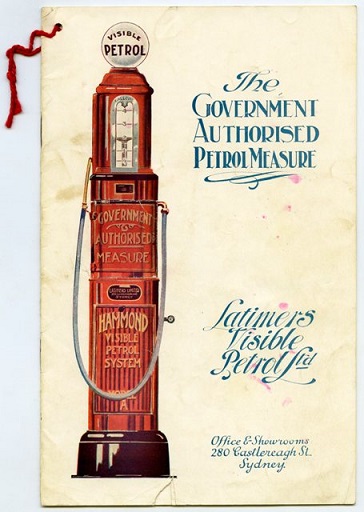HISTORY | STORIES | BEYOND BLOG & CREATE PEOPLE |
Footpath Mystery in Arcadia Street - Latimers' steel plate
Assuming that Castlereagh Street refers to the main Sydney city street, a search of Sand's Directories reveals that during the 1920s, a company called "Latimer Visible Petrol Ltd" whose business was described as motor systems had offices on the 2nd floor 280 Castlereagh Street Sydney. So assuming it was the base of a petrol bowser, a Google search shows what a fascinating and intriguing story leads from this humble piece of metal in a Coogee footpath.

Latimers Plate in Arcadia St
Young Sydney engineer Frank Hammond invented the "visible volumetric" petrol pump around 1920 and licensed his patent rights to manufacturers in Australia and the UK. Garages purchased visible pumps so that they could accurately measure the volume of petrol, or "motor spirit", dispensed to each customer. They wanted to convince customers that they were getting a fair deal, they didn't want to lose money by supplying more petrol than customers paid for, and gain an innovative edge over competing garages.

Latimers Leaflet for Hammond Petrol Pumps:
perhaps one of these stood in Arcadia Street
In Australia, Latimer's Visible Petrol Ltd manufactured Hammond pumps, which competed strongly against other brands, the best known of which was Bowser, named after the US inventor of the first service-station petrol pump, Sylvanus Freelove Bowser.
When municipal councils in Australia tried to ban all but Australian-made pumps from their footpaths in the 1920s, the Bowser company sued them in court arguing that the Australian content of its machines was high at 60%, with the remaining 40% of parts being made in another British Empire country, Canada. Latimer's Hammond pump was 100% Australian made.
In 1923 Bowser started selling its own visible pump in Australia. While 1927 saw only 65 petrol pumps imported from all overseas manufacturers, in 1928 the Atlantic Oil company ordered 500 for the string of service stations it planned to open here. In 1929, a few months after the Wall Street crash, the Australian Government increased the tariff payable on imported pumps to help local manufacturers compete. In 1931, Bowser auctioned off the contents of its Australian factory and office, blaming the "prohibitive tariff".
To generations of Australians and New Zealanders, "Bowser" was the generic term for petrol pumps, although in the rest of the world, terms such as "gas pumps" are used. The Bowser corporation also made petrol tankers, and in the UK, the term "bowser" refers to petrol tankers, not petrol station pumps. Ask for the location of a "petrol bowser" overseas, and you are likely to be met with a bemused stare. Considering the history of the pumps in Australia, it may be an accident of vocal history that they are not referred to as "Hammonds" or "Latimers" !
Copyright © Coogee Media All rights reserved.